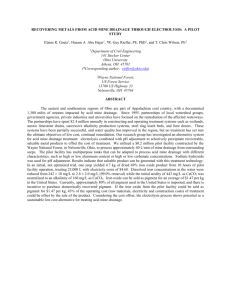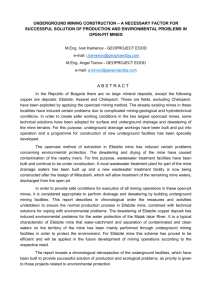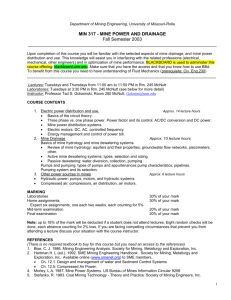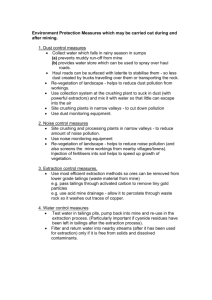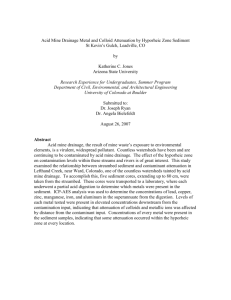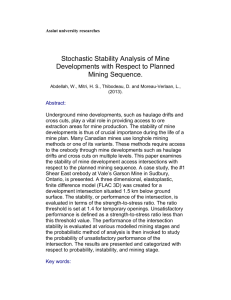Prof. Tracy-Lynn Humby
advertisement
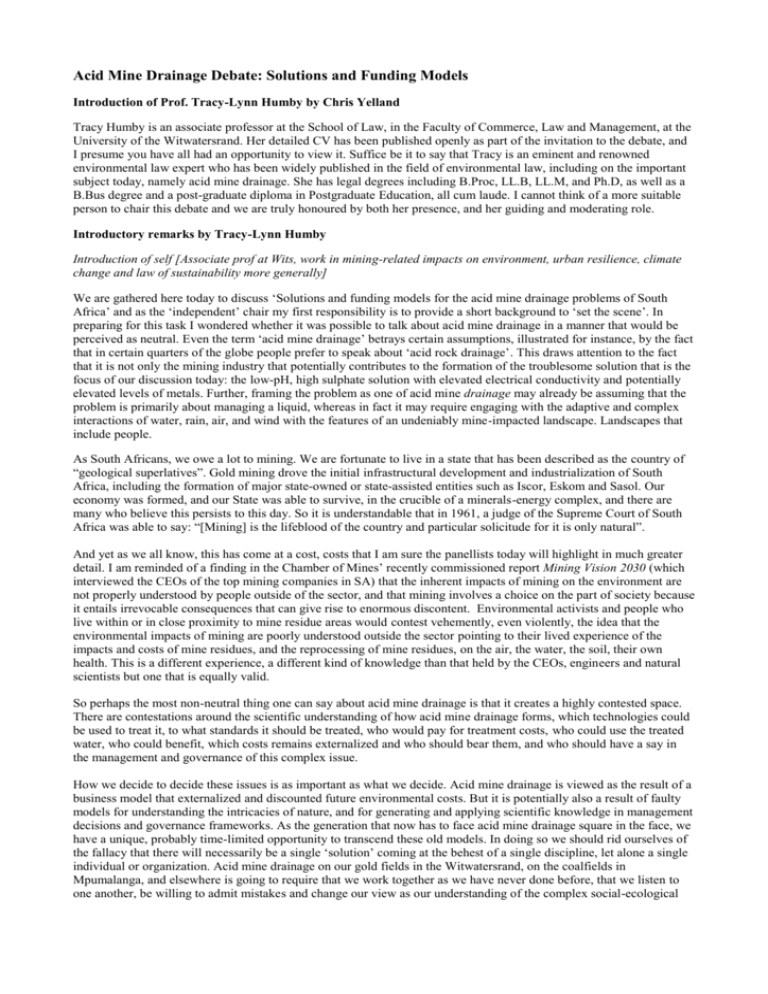
Acid Mine Drainage Debate: Solutions and Funding Models Introduction of Prof. Tracy-Lynn Humby by Chris Yelland Tracy Humby is an associate professor at the School of Law, in the Faculty of Commerce, Law and Management, at the University of the Witwatersrand. Her detailed CV has been published openly as part of the invitation to the debate, and I presume you have all had an opportunity to view it. Suffice be it to say that Tracy is an eminent and renowned environmental law expert who has been widely published in the field of environmental law, including on the important subject today, namely acid mine drainage. She has legal degrees including B.Proc, LL.B, LL.M, and Ph.D, as well as a B.Bus degree and a post-graduate diploma in Postgraduate Education, all cum laude. I cannot think of a more suitable person to chair this debate and we are truly honoured by both her presence, and her guiding and moderating role. Introductory remarks by Tracy-Lynn Humby Introduction of self [Associate prof at Wits, work in mining-related impacts on environment, urban resilience, climate change and law of sustainability more generally] We are gathered here today to discuss ‘Solutions and funding models for the acid mine drainage problems of South Africa’ and as the ‘independent’ chair my first responsibility is to provide a short background to ‘set the scene’. In preparing for this task I wondered whether it was possible to talk about acid mine drainage in a manner that would be perceived as neutral. Even the term ‘acid mine drainage’ betrays certain assumptions, illustrated for instance, by the fact that in certain quarters of the globe people prefer to speak about ‘acid rock drainage’. This draws attention to the fact that it is not only the mining industry that potentially contributes to the formation of the troublesome solution that is the focus of our discussion today: the low-pH, high sulphate solution with elevated electrical conductivity and potentially elevated levels of metals. Further, framing the problem as one of acid mine drainage may already be assuming that the problem is primarily about managing a liquid, whereas in fact it may require engaging with the adaptive and complex interactions of water, rain, air, and wind with the features of an undeniably mine-impacted landscape. Landscapes that include people. As South Africans, we owe a lot to mining. We are fortunate to live in a state that has been described as the country of “geological superlatives”. Gold mining drove the initial infrastructural development and industrialization of South Africa, including the formation of major state-owned or state-assisted entities such as Iscor, Eskom and Sasol. Our economy was formed, and our State was able to survive, in the crucible of a minerals-energy complex, and there are many who believe this persists to this day. So it is understandable that in 1961, a judge of the Supreme Court of South Africa was able to say: “[Mining] is the lifeblood of the country and particular solicitude for it is only natural”. And yet as we all know, this has come at a cost, costs that I am sure the panellists today will highlight in much greater detail. I am reminded of a finding in the Chamber of Mines’ recently commissioned report Mining Vision 2030 (which interviewed the CEOs of the top mining companies in SA) that the inherent impacts of mining on the environment are not properly understood by people outside of the sector, and that mining involves a choice on the part of society because it entails irrevocable consequences that can give rise to enormous discontent. Environmental activists and people who live within or in close proximity to mine residue areas would contest vehemently, even violently, the idea that the environmental impacts of mining are poorly understood outside the sector pointing to their lived experience of the impacts and costs of mine residues, and the reprocessing of mine residues, on the air, the water, the soil, their own health. This is a different experience, a different kind of knowledge than that held by the CEOs, engineers and natural scientists but one that is equally valid. So perhaps the most non-neutral thing one can say about acid mine drainage is that it creates a highly contested space. There are contestations around the scientific understanding of how acid mine drainage forms, which technologies could be used to treat it, to what standards it should be treated, who would pay for treatment costs, who could use the treated water, who could benefit, which costs remains externalized and who should bear them, and who should have a say in the management and governance of this complex issue. How we decide to decide these issues is as important as what we decide. Acid mine drainage is viewed as the result of a business model that externalized and discounted future environmental costs. But it is potentially also a result of faulty models for understanding the intricacies of nature, and for generating and applying scientific knowledge in management decisions and governance frameworks. As the generation that now has to face acid mine drainage square in the face, we have a unique, probably time-limited opportunity to transcend these old models. In doing so we should rid ourselves of the fallacy that there will necessarily be a single ‘solution’ coming at the behest of a single discipline, let alone a single individual or organization. Acid mine drainage on our gold fields in the Witwatersrand, on the coalfields in Mpumalanga, and elsewhere is going to require that we work together as we have never done before, that we listen to one another, be willing to admit mistakes and change our view as our understanding of the complex social-ecological systems underlying acid mine drainage improves over time. More than anything else it is going to require good will, good faith, trust, respect, and acknowledgement and appreciation for what we all can contribute. It is in this spirit that we can applaud EE Publisher’s initiative to host this public debate today and with pleasure that we will listen to the presentations of the four highly-eminent panelists before us. Introduction of Prof. Anthony Turton by Prof. Tracy-Lynn Humby Tony Turton is a professor in the Centre for Environmental Management at the University of Free State, a founding trustee of the Water Stewardship Council Trust, a co-founder of the South African Water, Energy and Food Forum (SAWEF), and a director of TouchStone Resources. His full CV has been circulated. Tony has bachelors, honours and masters degrees in political science, and a PhD in international politics. He has served and continues to serve on numerous local and international research institutes and bodies involved in water and environmental management. He had published very widely on the subject of water management, and has been a thought-leader in the field of acid mine drainage for many years. A debate on acid mine drainage without the input of Tony Turton would surely be missing something. Introduction of Ken Bouch by Prof. Tracy-Lynn Humby Ken Bouch is a chemical engineer and head of Fraser Alexander Water Treatment, a company involved in, amongst other activities, the treatment of acid mine drainage and the management of slimes dams in South Africa. His full CV has been circulated. Ken has a B.Eng cum laude in chemical engineering, and is a registered professional engineer with the Engineering Council of South Africa. Ken has been involved in the mining and extractive metallurgy industries for decades, with extensive operational, strategic, financial modeling and project experience, mainly in the gold, uranium, environmental and mine water treatment sectors. Introduction of Eddie Milne by Prof. Tracy-Lynn Humby Eddie Milne is the chief financial officer of Mintails South Africa, a company that owns a number of mining and prospecting rights in and around the West Rand gold fields. Mintails processes hard rock material and mine tailings through its gold beneficiation plants in Krugersdorp. The company is also involved in mine closure, environmental rehabilitation and treatment of acid mine drainage. Eddie’s full CV has been circulated. He has a B.Com degree in financial, cost and management accounting and tax. With wider operational and business experience at the heart of the subject matter of this debate, Eddie is ideally placed to present on sustainable business models associated with acid mine drainage and rehabilitation. Introduction of Mariette Liefferink by Prof. Tracy-Lynn Humby Mariette Liefferink is the chief executive officer of the Federation for a Sustainable Environment, widely recognised as the most prominent of the environmental activist stakeholders in the mining industry. Her full CV has been circulated. Mariette served on the board of the National Nuclear Regulator from 2009 to 2012, and is currently a member of the Dept of Water Affairs’ steering committee on the “Study for long-term solution to address the acid mine drainage associated with the East, Central and West Rand underground mining basins”. Mariette serves on many environmental committees and bodies, and has received numerous awards for her dedicated work. Of particular note, to mention just one, Mariette was awarded the Chancellor’s Medal of the North West University in 2009 for “her passionate and unselfish service to communities, and for her work with regard to injustices concerning the environment.” Mariette is truly an icon on the environmental activist landscape and we are honoured by her presence and her input to this debate.


